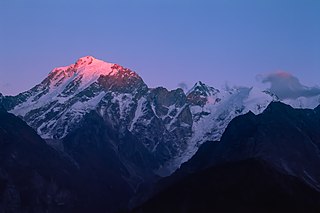
Himachal Pradesh is a state in the northern part of India. Situated in the Western Himalayas, it is one of the thirteen mountain states and is characterised by an extreme landscape featuring several peaks and extensive river systems. Himachal Pradesh is the northernmost state of India and shares borders with the union territories of Jammu and Kashmir and Ladakh to the north, and the states of Punjab to the west, Haryana to the southwest, Uttarakhand to the southeast and a very narrow border with Uttar Pradesh to the south. The state also shares an international border to the east with the Tibet Autonomous Region in China. Himachal Pradesh is also known as Dev Bhoomi or Dev Bhumi, meaning 'Land of Gods' and Veer Bhoomi which means 'Land of the Brave'.
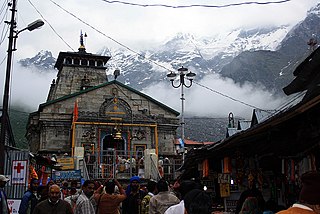
Garhwal is one of the two administrative divisions of the Indian state of Uttarakhand. Lying in the Himalayas, it is bounded on the north by Tibet, on the east by Kumaon, on the south by Uttar Pradesh state, and on the northwest by Himachal Pradesh state. It includes the districts of Chamoli, Dehradun, Haridwar, Pauri Garhwal, Rudraprayag, Tehri Garhwal, and Uttarkashi. The people of Garhwal are known as Garhwali and speak the Garhwali language. The administrative center for Garhwal division is the town of Pauri. The Divisional Commissioner is the administrative head of the Division, and is a senior Indian Administrative Service officer. As the administrative head of the division, the Commissioner is overall incharge of the 7 districts in the Garhwal region of Uttarakhand, and is aided in his duties by an additional commissioner and the district magistrates. Sushil Kumar is the divisional commissioner of the Garhwal Division since December 2021.
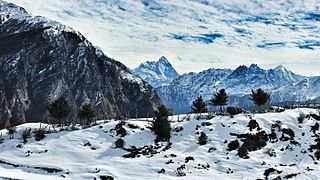
Uttarakhand, formerly known as Uttaranchal, is a state in northern India. The state is divided into two divisions, Garhwal and Kumaon, with a total of 13 districts. The winter capital and largest city of the state is Dehradun, which is also a railhead. On 5 March 2020, Bhararisain, a town in the Gairsain Tehsil of the Chamoli district, was declared as the summer capital of Uttarakhand. The High Court of the state is located in Nainital, but is to be moved to Haldwani in future.
The Western Pahari languages are a group of Northern Indo-Aryan languages spoken in Northern India, primarily in the state of Himachal Pradesh and Jammu.

Khas tribe, popularly known as Khashya, according to the 2015 constitution of Nepal are an Indo-Aryan ethno-linguistic group native to the Himalayan region of the Indian subcontinent, in what is now the present-day South Asian country of Nepal, as well as the Indian states of Uttarakhand, Himachal Pradesh, West Bengal, Assam and Sikkim. Historically, Khas were the speakers of an ancient Khas language from the Indo-Aryan language family and the earliest recorded speakers of the Western Pahari languages. The large portion of the Indo-Aryan speakers throughout lower Himalayas were the Khas people. An intrusion of this tribe from the Western and Northwestern Himalayas into Central Himalayas is substantiated by the early linguistic evidences related to the Nepali language. They were also known as Parbatiyas/Parbates and are currently known as Paharis/Pahadis.. They were also referred to as Yartse in Tibet and are also known as Khasan by Bhotia people. The term Khas has now become obsolete, as the Khas people have adopted communal identities because of the negative stereotypes associated with the term Khas. In Nepal the native speaker of Nepali language are known as Khas people.

Garhwali is an Indo-Aryan language of the Central Pahari subgroup. It is primarily spoken by over 2.5 million Garhwali people in the Garhwal region of the northern Indian state of Uttarakhand in the Indian Himalayas.

The Tons is the largest tributary of the Yamuna. It flows through Garhwal region in Uttarakhand, touching Himachal Pradesh. The Tons thrust is named after this river.
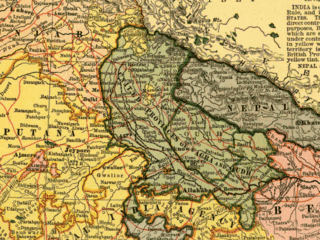
Garhwal District is a former district in Kumaon of British India of the United Provinces, and had an area of 5,629 sq mi (14,580 km2). It later became a part of the Indian state of Uttar Pradesh, today it is part of the Indian state Uttarakhand.
The North Indian state of Himachal Pradesh is a state that has remained largely uninfluenced by Western culture. Himachal Pradesh is a multi-religion practising, multicultural and multilingual state. Some of the most commonly spoken languages are Hindi and the various Pahari languages. The Hindu communities residing in Himachal include the Brahmins, Rajputs, Kannets, Rathis and Kolis. There is also a tribal population in the state which mainly comprises Gaddis, Kinnarms, Gujjars, Pangawals and Lahaulis.

Jaunsar-Bawar is a hilly region in Garhwal division of Uttarakhand, northern India. It is located in the north-west of Dehradun district, along the border with the state of Himachal Pradesh.

The Tākri script is an abugida writing system of the Brahmic family of scripts. It is derived from the Sharada script formerly employed for Kashmiri. It is the sister script of Laṇḍā scripts. It has another variant Dogra Takri employed in Jammu region. There are numerous varieties present throughout Himachal Pradesh. Until the late 1940s, the adapted version of the script was the official script for writing Dogri in the princely state of Jammu and Kashmir. Throughout the history, different kingdoms of what now forms Himachal Pradesh used their own variety to maintain their records. The Takri script used in Sirmour in Himachal Pradesh and in the adjacent region of Jaunsar-Bawar in Uttarakhand has some distinction.
The traditional dances of Himachal Pradesh are very complicated. These dances are a vital part of tribal life. It reflects the culture and the tradition of Himachal. Hardly any festivity there is celebrated without dancing. Dance forms such as Nati are performed all over the region.
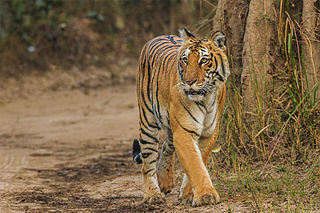
Uttarakhand is a Himalayan state in North India, nestled between the Tibetan Plateau and the Indo-Gangetic Plains. The name, which means "northern land" or "section" or "northern part" in Sanskrit was made popular in the 80s as part of the wider statehood struggle within the region.

Mandeali is an Indo-Aryan language spoken in northern India, predominantly in the Mandi district of Himachal Pradesh by the people of the Mandi Valley and particularly in the major city of Mandi. Other spellings for the name are Mandiyali and Mandiali. UNESCO reports it is one of the highly endangered languages of India. Speakers of the dialect have decreased by 21% from 1961 to 2001.
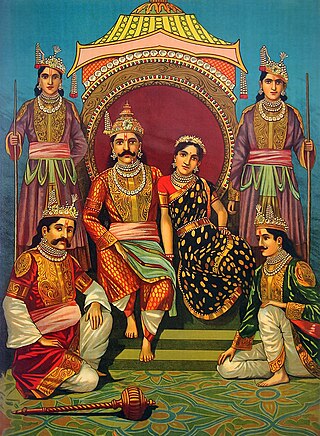
Polyandry in India refers to the practice of polyandry, whereby a woman has two or more husbands at the same time, either historically on the Indian subcontinent or currently in the country of India. An early example can be found in the Hindu epic Mahabharata, in which Draupadi, daughter of the king of Panchala, is married to five brothers.
Dhaam is a traditional feast celebrated in the Indian state of Himachal Pradesh, some parts of Punjab especially in Talwara and Mukerian region and Jammu region Dhaam is prepared and served on every joyful event or celebration in the family. Temples also serve dhaam on most of the religious festivals or auspicious dates.

Pahari Kinnauri, or Kinnauri Pahari, also known as Oras Boli, is a Western Pahari of northern India. It is spoken by different tribal groups in Kinnaur District, Himachal Pradesh; the language used to be commonly known as 'Kinnauri Tribal language', but this is now considered a derogatory term. It is not clear how distinct it is from other varieties of Himachali.

The Bodh people, also known as Khas Bhodi, are an ethnic group of Himachal Pradesh, India. They are found in Lahaul tehsil, Lahaul and Spiti district, predominantly in the Bhaga and Chandra valleys, but also to a lesser extent in Pattani valley, Miyar Valley, in the upper reaches of Pangi, Himachal Pradesh and Paddar valley, Jammu and Kashmir. Their religion is predominantly Buddhism with animistic and shaivite practices. Caste wise, they are identified as Rajput, Thakur or Kshetri although caste rules are not as rigid as in the plains. Historically, 3-4 prominent families of the area were accorded the titles of Rana, Wazir or Thakur by the kings of Chamba, Kullu or Ladakh for the purpose of general administration and revenue collection. They have a mix of martial traditions alongside shamanistic and lamaistic beliefs. Certain families/clans used to be significant zamindars/jagirdars. There is a significant cultural and ethnic mixing due to the region passing under the hegemony of rulers of Ladakh, Kullu and Chamba over the last many centuries. The language spoken differs from valley to valley with some dialects being very close to Kumaoni, while others are mixed with Chambyali and Dari. They are progressive, enterprising, honest and were involved in the centuries old India-Tibet-Nepal trading routes. Organized into family groups/clans with clan names ending in the suffix "-pa" similar to the "-ta" suffix found in the family/clan names of the Simla area.

Himachali cap is a distinctive headdress associated with Himachal Pradesh's culture. It is a part of the traditional dress of many Pahari inhabitants.
















